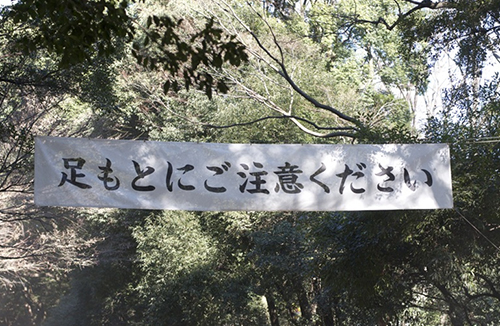File:RN157Image2.jpg
RN157Image2.jpg (500 × 326 pixels, file size: 213 KB, MIME type: image/jpeg)
Summary
足もとにご注意ください, poster by Christopher Acheson [1]
Original filename:
https://www.joyokanji.com/sites/default/files/shared/RN157Image2.jpg
Description
157. The "Foot" Radical: 足 For many of us the foot is an afterthought. Perhaps that's because it couldn't be farther from the brain, particularly from the eyes. Or maybe we devalue feet because they're often perceived as dirty.
But feet are essential. They are our foundations. They connect us to the earth, the surface we share with many other life forms. Massage therapists and those who work with reflexology put a premium on the feet. So does my dog trainer. She told me that the paw is where the most tension accumulates in a dog, so I should give my critters frequent paw massages!
In the kanji world, the foot is actually a bit less valuable, in that the "foot" radical 足 is on duty in just 11 Joyo kanji. But several of those kanji pop up quite often, increasing the importance of our radical.
Traditional Japanese socks have a separate compartment for the big toe. Such socks are known as 足袋 (たび). In this ateji term, the usual sounds of the kanji don't matter. But what does matter is the wonderful breakdown foot + bag; a sock is a bag for the feet!
The writing is faint on the labels, so it's tough to make out 文化足袋. The word 文化 (ぶんか) means "culture." I thought 文化足袋 might be a brand name. Apparently, though, the term refers to socks with tabi-shaped toe compartments but not the openings at the heels that traditional tabi have.
The 足 Kanji and 足 Radical The autonomous kanji 足 has a range of definitions:
足 (foot, leg; step; to walk; counter for pairs of footwear; suffice; "foot" radical) Henshall says that 足 is a pictograph combining a "kneecap" (口) with a "foot" (the bottom four strokes). All together these shapes mean "(lower) leg," he says.
In the 足 kanji (which has five Joyo readings, including あし), the radical is 足, also pronounced あし.
Just as the autonomous 足 kanji can mean "foot" or "leg," the radical can have either name in English. We'll go with "foot."
By the way, this radical has seven strokes.
The sign begins with the 足 kanji (and therefore with our radical!):
足もとにご注意ください
Please watch your step.
足もと (あしもと: one's step);
注意 (ちゅうい: being careful)
Incidentally, one can render 足もと entirely in kanji in these ways:
足下, which literally means "underfoot," breaking down as foot + under 足元, which doesn't literally mean "origin (元) of the foot" but instead breaks down as foot + where something is
The "Foot" Radical on the Left
The "Foot" Radical on the Left Of the 11 Joyo kanji with 足 as an on-duty radical, the 足 kanji stands alone from a design perspective. The other 10 characters feature this radical on the left, as these three examples do:
践 (1495: to carry out)
跳 (1595: to jump)
踊 (1880: dance)
On the left side of a kanji, the radical changes shape. The radical name changes, too, becoming あしへん (足編). The 編 means "left-side radical."
..
In the city of Kobe, another sign starts with our radical! It heads off this word:
路地裏 (ろじうら: back street; back alley; off-street) alley (1st 2 kanji) + back The restaurant name translates as "Back Alley Italian"!
The kanji of interest here is 路 (415: route).
References
- ↑ https://www.joyokanji.com/radical-notes/157-foot-radical-足 157. The "Foot" Radical: 足 (2021)
File history
Click on a date/time to view the file as it appeared at that time.
| Date/Time | Thumbnail | Dimensions | User | Comment | |
|---|---|---|---|---|---|
| current | 04:21, 31 August 2021 |  | 500 × 326 (213 KB) | T (talk | contribs) | 足もとにご注意ください, poster by Christopher Acheson <ref> https://www.joyokanji.com/radical-notes/157-foot-radical-足 157. The "Foot" Radical: 足 (2021) </ref> Original filename: https://www.joyokanji.com/sites/default/files/shared... |
You cannot overwrite this file.
File usage
The following 2 pages use this file:
